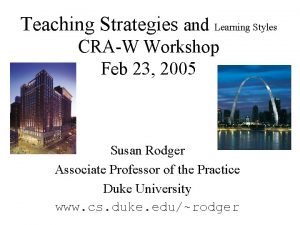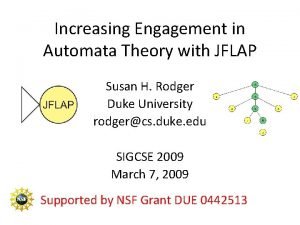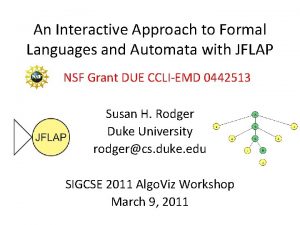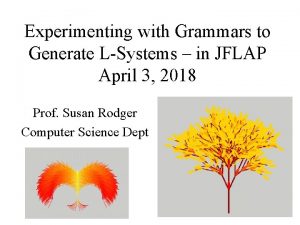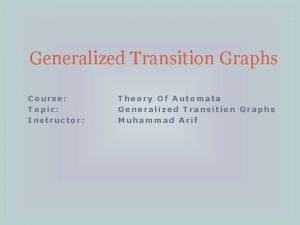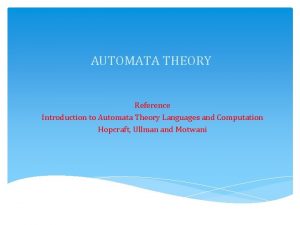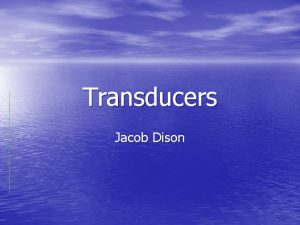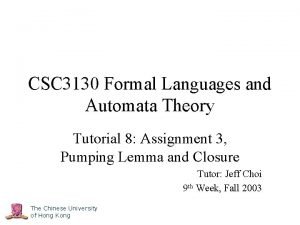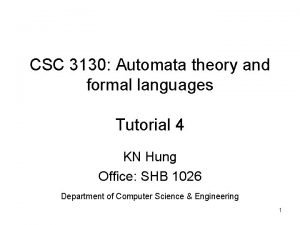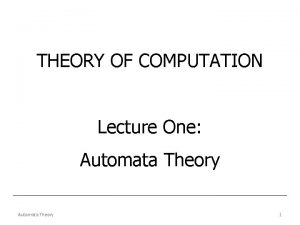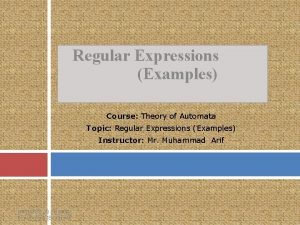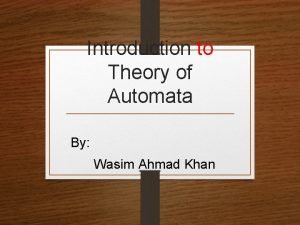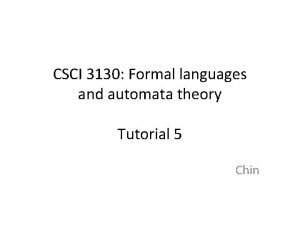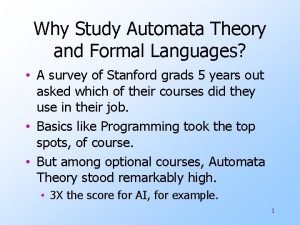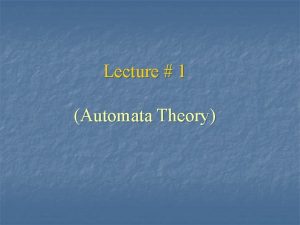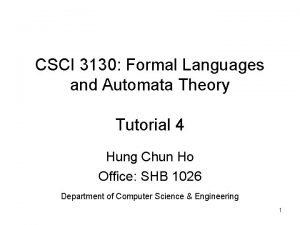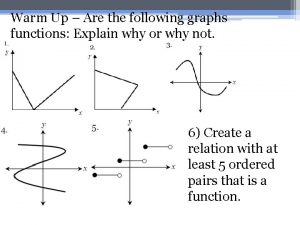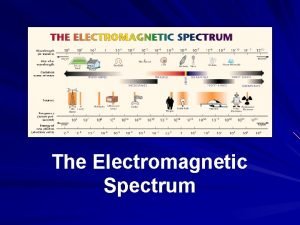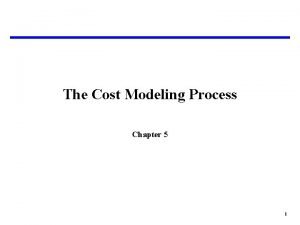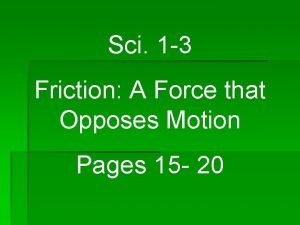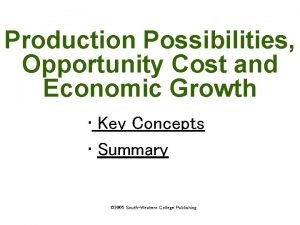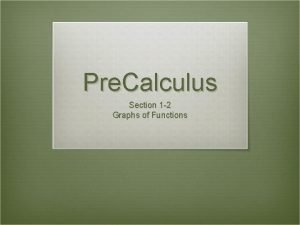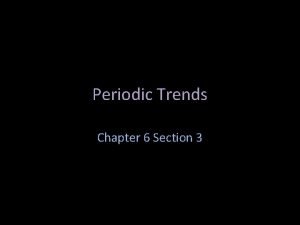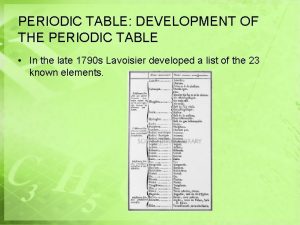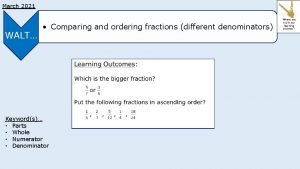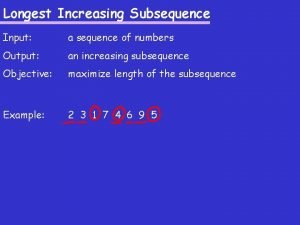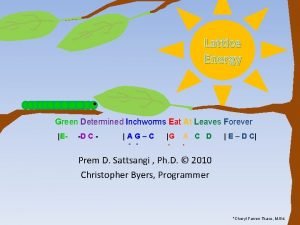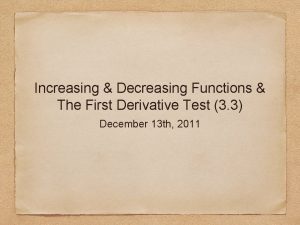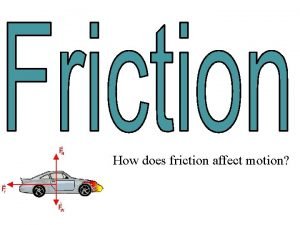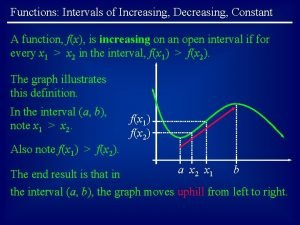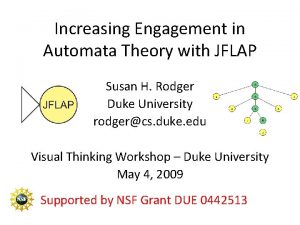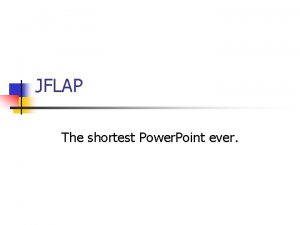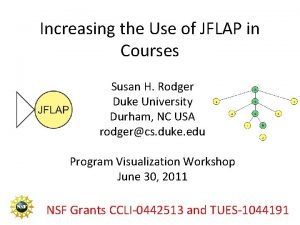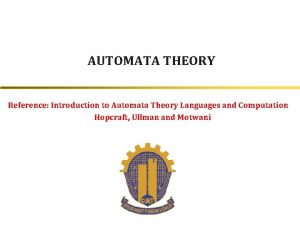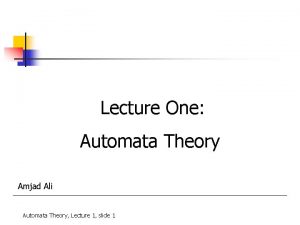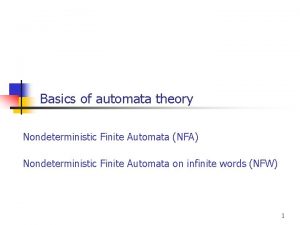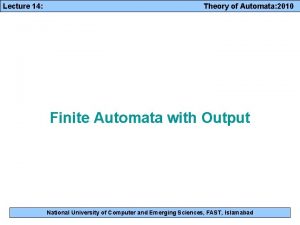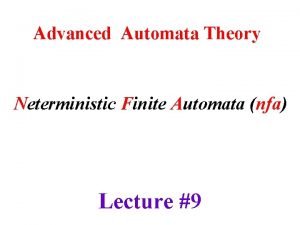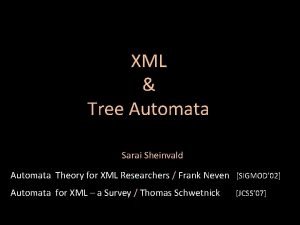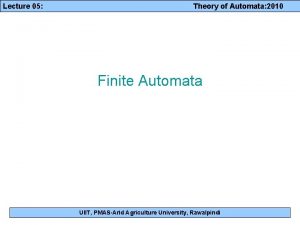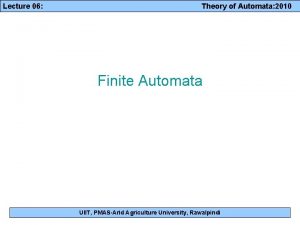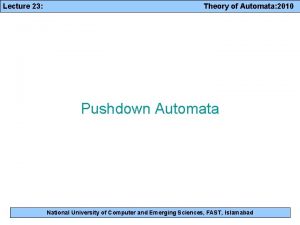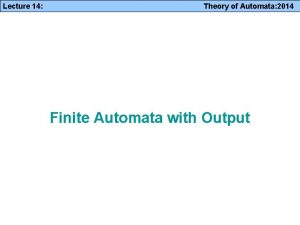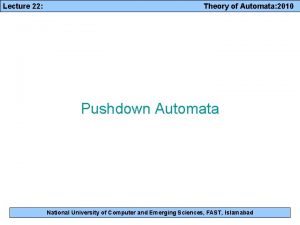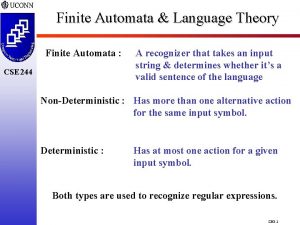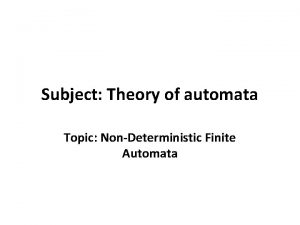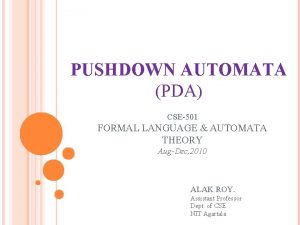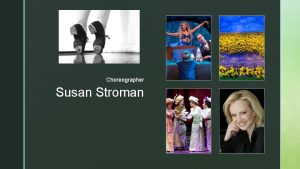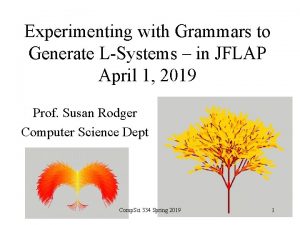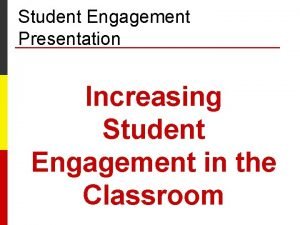Increasing Engagement in Automata Theory with JFLAP Susan








































- Slides: 40

Increasing Engagement in Automata Theory with JFLAP Susan H. Rodger Duke University rodger@cs. duke. edu SIGCSE 2009 March 7, 2009 Supported by NSF Grant DUE 0442513

Co-Authors • Evaluators - NCSU – Eric Wiebe – Kareem Omar • Undergraduates - Duke – Kyung Min Lee – Chris Morgan – Jonathan Su

Outline • Introduction and Overview of JFLAP • JFLAP Two-year Study and Results • New Items in JFLAP – User Control Parser – CYK Parser – Expanding Pumping Lemma – Turing machine to Unrestricted Grammar – Others • Conclusions and Future Work

Formal Languages and Automata Theory • Traditionally taught – Pencil and paper exercises – No immediate feedback • Different – More mathematical than most CS courses – Less hands-on than most CS courses – Programming is in most of their CS courses, not here

Why Develop Tools for Automata? Textual Tabular Visual Interactive

Overview of JFLAP • Java Formal Languages and Automata Package • Instructional tool to learn concepts of Formal Languages and Automata Theory • Topics: – Regular Languages – Context-Free Languages – Recursively Enumerable Languages – Lsystems • With JFLAP your creations come to life!

Thanks to Students - Worked on JFLAP and Automata Theory Tools Over 17 years! • NPDA - 1990, C++, Dan Caugherty • FLAP - 1991, C++, Mark Lo. Sacco, Greg Badros • JFLAP - 1996 -1999, Java version Eric Gramond, Ted Hung, Magda and Octavian Procopiuc • Pâté, Je. LLRap, Lsys Anna Bilska, Jason Salemme, Lenore Ramm, Alex Karweit, Robyn Geer • JFLAP 4. 0 – 2003, Thomas Finley, Ryan Cavalcante • JFLAP 6. 0 – 2005 -2008 Stephen Reading, Bart Bressler, Jinghui Lim, Chris Morgan, Jason Lee, Jonathan Su

JFLAP – Regular Languages • Create – DFA and NFA – Moore and Mealy – regular grammar – regular expression • Conversions – NFA to DFA to minimal DFA – NFA regular expression – NFA regular grammar

JFLAP – Regular languages (more) • Simulate DFA and NFA – Step with Closure or Step by State – Fast Run – Multiple Run • • Combine two DFA Compare Equivalence Brute Force Parser Pumping Lemma

JFLAP – Context-free Languages • Create – Nondeterministic PDA – Context-free grammar – Pumping Lemma • Transform – PDA CFG – CFG PDA (LL & SLR parser) – CFG CNF – CFG Parse table (LL and SLR) – CFG Brute Force Parser

JFLAP – Recursively Enumerable Languages • Create – Turing Machine (1 -Tape) – Turing Machine (multi-tape) – Building Blocks – Unrestricted grammar • Parsing – Unrestricted grammar with brute force parser

JFLAP - L-Systems • This L-System renders as a tree that grows larger with each successive derivation step.

Students love L-Systems

Other Tools for Automata • • Turing’s World (Barwise and Etchemendy) Deus Ex Machina (Taylor and Savoiu) Theory of Computing Hypertextbook (Ross) Many others – L-System tools – Compiler tools – Finite State machine tools

JFLAP Study • Study of JFLAP’s effectiveness in learning – Two year study – Fourteen Faculty Adopters – Two 2 -day faculty Adopter Workshops – June 2005, June 2006 – Collect data 2005 -06 and 2006 -07 Academic years – Pretest/Posttest – Interviews – Team of three evaluators • Eric Weibe – Education • Rocky Ross – Computer Science Theory • Joe Bergin – Computer Science Tools

Fourteen Faculty Adopter Participants -small, large - public, private - includes minority institutions • • • • Duke UNC-Chapel Hill Emory Winston-Salem State University United States Naval Academy Rensselaer Polytechnic Institute UC Davis Virginia State University Norfolk State University of Houston Fayetteville State University of Richmond San Jose State University Rochester Institute of Technology

We hoped to show with this learning approach… • Students gain a better and deeper understanding of FLA • Students are happier and more confident in learning FLA • Students are more interested in using the tools on their own • Instructors can easily use the tools in class • Instructors can easily grade electronic submissions

Goals of the JFLAP Study Formal Languages and Automata (FLA) • Present FLA in a visual and interactive manner in addition to the more traditional approach – Integrated • Present Applications of FLA • Provide a tool for allowing students to explore FLA in a computational manner • Provide Materials for instructors to integrate this approach in their courses

Running a Study is hard! • Hit by the drop In enrollments in after dot-com burst • IRBs are different process at every institution – One page writeup ok’d (simplest) – Full medical IRB (many pages) • One institution shut down all IRB research projects – we could not use data already collected. • One University - Control Group – different times means different types of students, different professors. • Some faculty came to workshop and did not follow through • There were also some fantastic faculty!

Year One Instructor Interviews • Used JFLAP in their courses – Primary use in class – demonstrations – Some used it to generate the graphics for their lecture – Extensive use – homeworks – includes electronic submission – One used it in office hours

Year One – Software Implementation

Years 1 and 2: Usability Survey

Year 2 – Implementation Survey

Year 2 – Usability Survey

New Items in JFLAP • User-Control Parser (UCP) – Allows for more exploration

UCP – select rule, select variable, Step

UCP – final parse tree

CYK Parser • Cocke-Younger-Kasami (CYK) • How it works in JFLAP – Internally, convert to CNF grammar – Then map back to original grammar

CYK – substantially faster than Brute Force Parser for many grammars • Brute Force Parser 8 secs • CYK parser 1 sec

Pumping Lemma Game – Linz Book

t ww^R

Turing Machine to Unrestricted Grammar

Other New Items • Can automatically add a trap state • Additional graph layout choices • Can load an input string from a file – This is useful for universal Turing machine • Online JFLAP Tutorial • JFLAP wiki and listserv

Getting interaction into the automata theory course…… There are lots of ways to get interaction in this course…

Students Work in Groups to Solve Problems – With or W/out JFLAP • Lecture some, then stop • Students work on problem with JFLAP • Bring students back together

Interaction in Class – Props Edible Turing Machine • TM for f(x)=2 x where x is unary • TM is not correct, can you fix it? Then eat it! • States are blueberry muffins

Students building DFA with cookies and icing

JFLAP’s Use Around the World • JFLAP web page has over 200, 000 hits since 1996 • Google Search – JFLAP appears on over 9830 web pages – Note: search only public web pages • JFLAP been downloaded in over 160 countries

Conclusions From Study • Results of Study showed – All the faculty used JFLAP in their courses, mostly for homework, some in lecture – Students had a high opinion of JFLAP – Majority of students felt access to JFLAP • Made learning course concepts easier • Made them feel more engaged • Made the course more enjoyable – Over half the students used JFLAP to study for exams – Over half the student thought time and effort using JFLAP helped them get a better grade.

Resources/Questions? www. jflap. org JFLAP works well with Linz book New CD supplement with JFLAP exercises to go with this book JFLAP tutorial
 Jflap
Jflap Jflap
Jflap Automata
Automata Jflap grammar
Jflap grammar Gtg in theory of automata
Gtg in theory of automata Central concepts of automata theory in flat
Central concepts of automata theory in flat Bidirectional transducers in automata theory
Bidirectional transducers in automata theory Formal languages and automata theory tutorial
Formal languages and automata theory tutorial Formal languages and automata theory tutorial
Formal languages and automata theory tutorial Cyk algorithm
Cyk algorithm Automata theory
Automata theory Automata theory
Automata theory Is regular expression a language
Is regular expression a language Difference between valid and invalid alphabets in automata
Difference between valid and invalid alphabets in automata Cyk algorithm
Cyk algorithm Csci 3130
Csci 3130 Formal languages and automata theory tutorial
Formal languages and automata theory tutorial Aaaaaabb
Aaaaaabb Why we study automata theory
Why we study automata theory Reverse of a string in automata theory
Reverse of a string in automata theory Csci3130
Csci3130 Graphing transformations
Graphing transformations How to arrange elements in increasing atomic size
How to arrange elements in increasing atomic size Electromagenetic spectrum
Electromagenetic spectrum Increasing at a decreasing rate
Increasing at a decreasing rate Increasing friction
Increasing friction The law of increasing opportunity costs states that
The law of increasing opportunity costs states that How to find increasing and decreasing intervals on a graph
How to find increasing and decreasing intervals on a graph All periodic trends
All periodic trends Fr atomic radius
Fr atomic radius Atomic size
Atomic size Increasing atomic size
Increasing atomic size Periodic relationships
Periodic relationships Ordering fractions
Ordering fractions Longest increasing subsequence
Longest increasing subsequence δhof
δhof Lesson 5 increasing and decreasing functions
Lesson 5 increasing and decreasing functions What causes friction
What causes friction Development refers to
Development refers to Thermal stability of group 2 nitrates
Thermal stability of group 2 nitrates Increasing function
Increasing function
